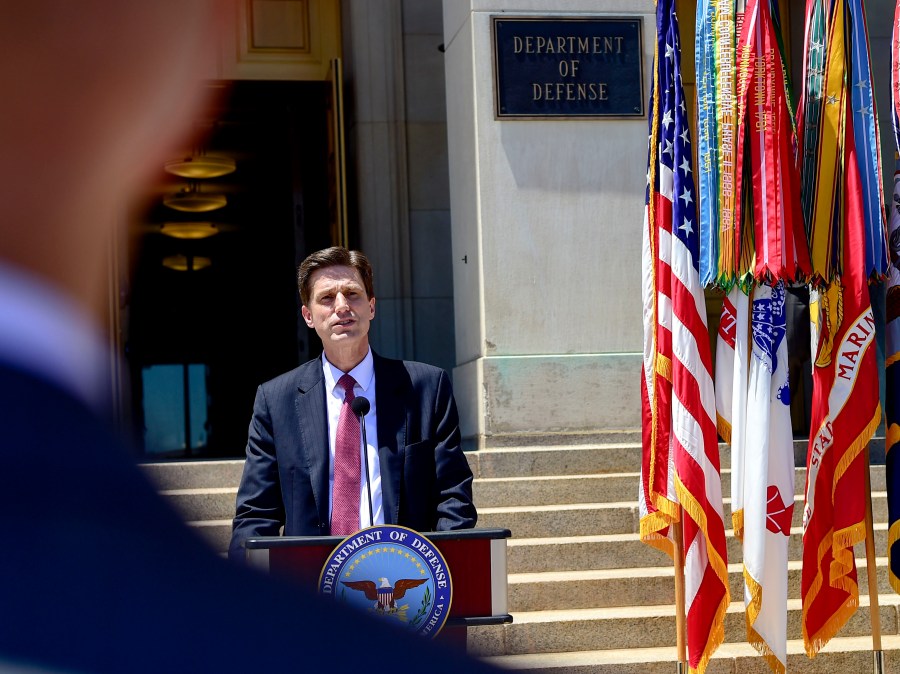Artificial intelligence is the heart of CIO Dana Deasy’s plan to modernize the DOD

The move to adopt commercial, enterprise cloud capabilities has dominated discussion in 2018 around the Department of Defense’s modernization efforts. But according to new CIO Dana Deasy, cloud services are just a piece of the foundation for DOD’s plans to make artificial intelligence “the agent of transformation.”
Deasy said the Pentagon is embarking on the third wave of AI, when “computers will no longer be seen as tools but instead as a partner.”
“As artificial intelligence matures, we must redefine the role of computers in warfighting. So how exactly will computers be seen as our partner? Casual reasoning, performance robustness, and ever brain control or prosthetic limbs, just to name a few examples,” he said, speaking extensively about DOD’s AI initiatives at the DoDIIS Worldwide conference in Omaha, Nebraska earlier this month.
In the current “second wave” of AI, driven by machine learning, Deasy said the Pentagon is learning the science behind the technology and how best to apply it.
“Our knowledge of what AI does better than humans will ultimately lead to a robust human-machine partnership,” he said. “Without a doubt, the anticipated outcome of this partnership is architectural superiority that gives our forces an asymmetric advantage across the full spectrum of conflict.”
Already in Deasy’s three months as CIO, the department has stood up the Joint AI Center and submitted an “extremely comprehensive” DOD AI Strategy to Congress.
“Our current AI capabilities will not be sustainable in order to compete and dominate in the current and emerging threat environment,” he said. “So we must translate AI into decisions and impact. However, large challenges remain ahead for the DOD if we want to gain advantage with speed and agility.”
But it is crucial, he argues, to set the right foundation with the cloud and with data management within the department.
“The cloud is truly going to allow technology advances in the way we’ve never seen it be possible in the past. All missions in the DOD, from intelligence, the back office, process reform will benefit from the cloud,” Deasy said. Cloud — particularly the one the department will procure as part of the Joint Enterprise Defense Infrastructure (JEDI) program — needs to be the “basis to allow the agent of change to AI.”
And without accurate data, “AI is irrelevant,” he explained.
“Data is the common denominator for any successful artificial intelligence program,” Deasy said. “AI will not succeed … without accurate data, which is our strategic asset. The problem we face is: Where is that data? What is the format of that data? How do we access that data? And most importantly, how do we churn that raw, unstructured data in the right way that we can produce smart algorithms.”
He pointed to a common anecdote in the Air Force — the service is said to process more operational data in a day than all of the film the NFL has shot and archived in the past five years.
“We are currently not lacking in data inside the Department of Defense,” Deasy said. “But it is becoming increasingly apparent we must be mindful of how we use this data. Our challenge is at DOD to discover, access, retrieve, analyze and share all the sources of data whenever and wherever our warfighter needs it. It sounds simple, but we all know, if you break that sentence apart, that is an ambitious undertaking.”
The Joint AI Center is still in an “embryonic stage,” and Deasy emphasized that it’s an initiative that will take many more organizations — those from the rest of the federal government, the intelligence community, private industry, academia and so on — to make it effective.
“The JAIC is not only about attracting world-class talent across the Department of Defense, i.e. the idea of bringing the best and brightest minds together, but it’s also going to bring traditional and non-traditional innovators together in a way that we’ve never seen before,” he said. “And it’s also a point that this isn’t just about the Department of Defense…we need to bring in the entire federal government, private sector, academia and of course our allies on this journey.”






